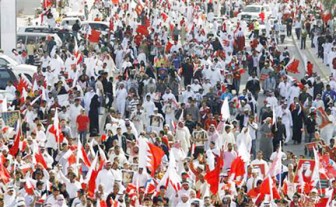MANAMA, (Reuters) – Bahraini security forces fired on protesters yesterday, wounding dozens, and thousands demonstrated in Libya after a deadly government crackdown as pro-democracy unrest in the Middle East and North Africa turned increasingly violent.
While millions of Egyptians staged a “Victory March” feting their overthrow of autocrat Hosni Mubarak last week after 30 years, protesters elsewhere, inspired by their success, pursued struggles against their own authoritarian rulers.
At least 60 people were wounded yesterday near Pearl Square in the Bahraini capital, Manama, a day after police swept away a protest camp from the traffic circle in the city, killing four people and wounding more than 230.

At least five people were killed in Yemen on Friday when security forces and pro-government loyalists clashed with crowds demanding an end to President Ali Abdullah Saleh’s 32-year rule.
In Libya, thousands of people protested in the North African country’s second-biggest city of Benghazi over a security crackdown that has killed dozens of people but failed to halt the worst unrest of Muammar Gaddafi’s four decades in power.
The spreading contagion of unrest — particularly worries about its possible effects on the world No. 1 oil producer, Saudi Arabia, helped drive Brent crude prices higher this week before other factors caused them to slip yesterday.
It was also a factor in gold prices posting their best weekly performance since December.
‘LIVE BULLETS’
In Bahrain, Ali Ibrahim, deputy chief of medical staff at Salmaniya hospital, said 66 people had been admitted suffering wounds from the clash in Pearl Square. Four were in critical condition.
“We think it was the army,” former lawmaker Sayed Hadi said of the shootings. He is a member of Wefaq, the main Shi’ite bloc, which resigned from parliament on Thursday.
Protester Fakhri Abdullah Rashed said he had seen soldiers shooting at demonstrators in Pearl Square. “I saw people shot in several parts of their body. It was live bullets,” he added.
About 1,000 emotional people gathered outside a hospital, some spilling into the corridors as casualties were brought in, including one with a bloody sheet over his head. King Hamad bin Isa al-Khalifa announced he had asked the crown prince to start a national dialogue “with all parties” to resolve the crisis rocking the island kingdom.
Bahrain’s most revered Shi’ite cleric, Sheikh Issa Qassem, described the police attack as a “massacre” and said the government had shut the door to dialogue. But he stopped short of calling openly for street protests.
It was the worst bloodshed in the Saudi-allied Gulf island kingdom in decades and underlined the jitters of its Sunni royal family, long aware of simmering discontent among the majority Shi’ites.
The army in Bahrain, a country of 1.3 million people of whom 600,000 are native Bahrainis, had issued a warning to people to stay away from the center of the capital.
The unrest has presented the United States with a now familiar dilemma. It is torn between its desire for stability in a long-standing Arab ally and a need to uphold its own principles about the right of people to demonstrate for democratic change.
“I am deeply concerned by reports of violence in Bahrain, Libya and Yemen. The United States condemns the use of violence by governments against peaceful protesters in those countries, and wherever else it may occur,” President Barack Obama said in a statement.
Bahrain hosts the U.S. Navy’s Fifth Fleet, which projects U.S. military muscle across the Middle East and Central Asia, and the tension could fuel discontent among the Shi’ite minority in neighboring Saudi Arabia.
YEMEN GRENADE
ATTACK
In Yemen, doctors said four people died from gunfire in the southern port of Aden, where resentment against rule from the capital, Sanaa, runs high. One person was killed and 28 wounded when a grenade was thrown from a car into a crowd in Taiz, south of Sanaa.
Tens of thousands of anti-government protesters thronged Taiz, where pro-government crowds also turned out, and there were smaller rival demonstrations in Sanaa. In Aden, thousands of protesters angered by what they said was excessive force by security forces, stayed in the streets for hours.
Some broke away and set fire to a building formerly used by police, while others threw rocks at a local government office in the heart of the southern port town, witnesses said. Yemeni leader Saleh, a U.S. ally against a Yemen-based al Qaeda wing that has launched attacks at home and abroad, is struggling to defuse protests demanding political change and jobs.
In Libya, opposition activists said protesters were fighting troops for control of Al Bayda, a town 200 km (125 miles) northeast of Benghazi.
Al Bayda was the scene of some of the worst violence over the past two days, where townspeople said they were burying 14 people killed in earlier clashes.
Human rights group Amnesty International said it believed Libyan security forces had shot and killed at least 46 people in the past three days.
In Egypt, millions took to the streets to celebrate Mubarak’s downfall and to remind the country’s military rulers to keep their promise of a swift transition to democracy.
The emotional day was also a memorial to the 365 people who died in the uprising and many said they would hold the military to promises of elections within six months.





